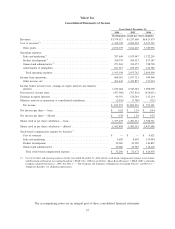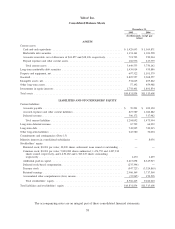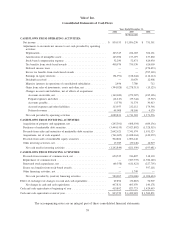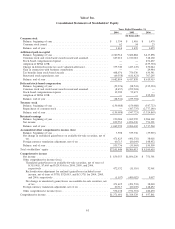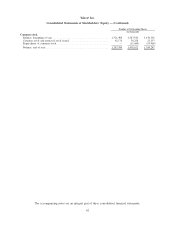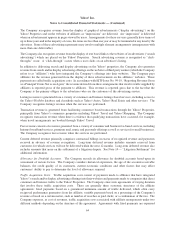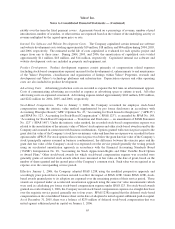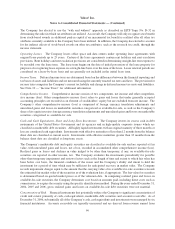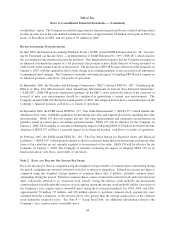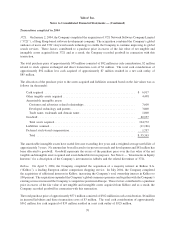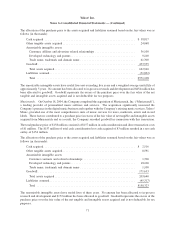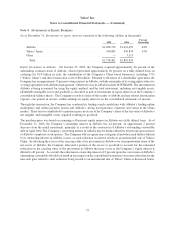Yahoo 2006 Annual Report Download - page 77
Download and view the complete annual report
Please find page 77 of the 2006 Yahoo annual report below. You can navigate through the pages in the report by either clicking on the pages listed below, or by using the keyword search tool below to find specific information within the annual report.customers. The Company performs ongoing credit evaluations of its customers and maintains allowances for
potential credit losses. Historically, such losses have been within management’s expectations. As of December 31,
2005 and 2006, no one customer accounted for 10 percent or more of the accounts receivable balance and no one
customer accounted for 10 percent or more of the Company’s revenues for 2004, 2005, or 2006.
Long-Lived Assets.
Property and Equipment. Buildings are stated at cost and depreciated using the straight-line method over the
estimated useful lives of 25 years. Leasehold improvements are amortized over the lesser of their expected useful
life and the remaining lease term. Computers and equipment and furniture and fixtures are stated at cost and
depreciated using the straight-line method over the estimated useful lives of the assets, generally two to five years.
The Company recognized depreciation expense on property and equipment of approximately $165 million,
$224 million, and $302 million for 2004, 2005, and 2006, respectively. The Company also capitalized $14 million
of stock-based compensation expense in the year ended December 31, 2006.
Goodwill. Goodwill is carried at cost. Goodwill is not amortized but is subject to an annual test for impairment at
the reporting unit level (operating segment or one level below an operating segment) and between annual tests in
certain circumstances. The performance of the test involves a two-step process. The first step of the impairment test
involves comparing the fair value of the Company’s reporting units with the reporting unit’s carrying amount,
including goodwill. The Company generally determines the fair value of its reporting units using the expected
present value of future cash flows, giving consideration to the market valuation approach. If the carrying amount of
a reporting unit exceeds the reporting unit’s fair value, the Company performs the second step of the goodwill
impairment test to determine the amount of impairment loss, if any.
Intangible Assets Other than Goodwill. Intangible assets other than goodwill are carried at cost less accumulated
amortization. Intangible assets are generally amortized on a straight-line basis over the useful lives of the respective
assets, generally two to seven years. Long-lived assets and certain identifiable intangible assets to be held and used
are reviewed for impairment whenever events or changes in circumstances indicate that the carrying amount of such
assets may not be recoverable. Determination of recoverability is based on an estimate of undiscounted future cash
flows resulting from the use of the asset and its eventual disposition. Measurement of any impairment loss for long-
lived assets and certain identifiable intangible assets that management expects to hold and use is based on the
amount the carrying value exceeds the fair value of the asset.
Investments in Equity Interests. Investments in entities in which the Company can exercise significant influence
but does not own a majority equity interest or otherwise control, are accounted for using the equity method and
included as Investments in equity interests on the consolidated balance sheets. The Company records its share of the
results of these companies one quarter in arrears within earnings in equity interests on the consolidated statements
of income. The Company monitors its investments for other-than-temporary impairment by considering factors
including the stock price of public companies in which it has an equity investment as well as current economic and
market conditions and the operating performance of the companies and records reductions in carrying values when
necessary. The fair value of privately held investments is estimated using the best available information as of the
valuation date, including current earnings trends, undiscounted cash flows, quoted stock prices of comparable
public companies, and other company specific information, including recent financing rounds.
The carrying amounts of these investments are greater than the underlying equity in net assets of these companies in
certain cases due in part to goodwill, which is not subject to amortization in accordance with SFAS No. 142
“Goodwill and Other Intangible Assets” (“SFAS 142”). This goodwill is evaluated for impairment in accordance
with APB Opinion No. 18, “The Equity Method of Accounting for Investments in Common Stock.”
Foreign Currency. The functional currency of the Company’s international subsidiaries is generally the local
currency. The financial statements of these subsidiaries are translated into United States dollars using period-end
rates of exchange for assets and liabilities and average rates of exchange for the period for revenues and expenses.
Translation gains (losses) are recorded in accumulated other comprehensive income (loss) as a component of
67
Yahoo! Inc.
Notes to Consolidated Financial Statements — (Continued)


